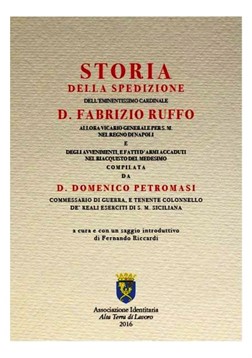Saturday, March 24 h. 17 - Ruskin Library, Pescara Central Station
A weekend of culture: Riots forget
The outbreaks in Abruzzo and southern Italy
Fra Diavolo, Giuseppe Pronio and Cardinal Fabrizio Ruffo
The Sanfedists, the reaction to the invasion, 1799, Fra Diavolo. Topics to be covered by the journalistFernando RiccardiSaturday, March 24 to 17, in Ruskin Library, hall Central Station Fs of Pescara, together with Claudio Saltarelli, Publisher of the book "History of Shipping Eminent Cardinal Fabrizio Ruffo. "An important event in the context of A weekend of culture organized by Fontevecchia, To know the history of Abruzzo outbreaks and the "General" Giuseppe Pronio: Abbot, Armiger and capomassa. 
The Association IDENTITY "Alta Terra di Lavoro"He has edited the reprint of"History of Cardinal Ruffo Shipping, "By Domenico Petromasi, Dating back to 1801. A full-bodied and very detailed introductory essay to the historic signing Fernando Riccardi, Reconstructs, step by step and in detail, the extraordinary enterprise that in 1799 brought the cardinal Calabrian Fabrizio Ruffoto reconquer the Kingdom of Naples, invaded by the Jacobins, with its "armed and real Christian," composed largely of volunteers gathered along the way under the emblem of the Holy Cross. It was then that he was born of the epic Sanfedists, of lazzari, the insurgents, the robbers, theMichele Pezza, alias Fra 'Diavolo.
 It will be an opportunity to also speak of "outbreaks of Abruzzo"Historical phenomenon 219 years ago and illustrate the figure of Giuseppe PronioBorn in 1760 in Introdacqua, a man of some culture and prosperous civil and family after being cleric, became armigero the Marquis of Vasto. Married with children, with the arrival of the French army it became one of the most skilled and feared capimassa the northern parts of the Kingdom. Having become the leader of 700 men became Pronio "capomassa"Ie guide of the robbers and, as a result, affiliating to Bourbon cause, Ferdinand IV, June 2, 1799, named him general and commander of the Abruzzi. Legendary for its beauty and charm, Pronio was a gentleman bandit who did not tolerate the abuses and that with his courage, he managed to regain Ripa Teatina, where the French had done the massacre of the local monastery monks, Chieti, Ortona, Lanciano, Vasto and even tried to free Pescara defense Carafa. As he sank into oblivion after the Battle of the Tronto in 1801, only to reappear in 1804 in Naples where he died with the rank of colonel Bourbon.
It will be an opportunity to also speak of "outbreaks of Abruzzo"Historical phenomenon 219 years ago and illustrate the figure of Giuseppe PronioBorn in 1760 in Introdacqua, a man of some culture and prosperous civil and family after being cleric, became armigero the Marquis of Vasto. Married with children, with the arrival of the French army it became one of the most skilled and feared capimassa the northern parts of the Kingdom. Having become the leader of 700 men became Pronio "capomassa"Ie guide of the robbers and, as a result, affiliating to Bourbon cause, Ferdinand IV, June 2, 1799, named him general and commander of the Abruzzi. Legendary for its beauty and charm, Pronio was a gentleman bandit who did not tolerate the abuses and that with his courage, he managed to regain Ripa Teatina, where the French had done the massacre of the local monastery monks, Chieti, Ortona, Lanciano, Vasto and even tried to free Pescara defense Carafa. As he sank into oblivion after the Battle of the Tronto in 1801, only to reappear in 1804 in Naples where he died with the rank of colonel Bourbon.
The name most famous enterprise sanfedista, however, remains that of Fra 'Diavolo, Aka Michele PezzaItri. Michele, a young physically undersized but from the easy knife, owes its nickname to the vow made by his mother, as a child, and for many years, as a Franciscan habit. When answering the call of Cardinal Ruffo, at 25, already he has a price on his head. The head of Sanfedists gave him the territory between Cassino, Caserta and Capua. It is said that in a few days be able to put together a band of over two thousand acolytes. His quick actions by guerrilla procure some damage to the French retreat while the territory occupied by his gang, on maps, is marked by a red circle; right to report the danger!

Also for Michele Pezza It indulges the popular tradition which consists:
Fra'Diavolo arrived
Led cannuncini
P'ammazzà the giacobbini.
Ferdinand is our King!
Fra'Diavolo alone
He won the Gauls,
the long few months
We 're the King!
After the fall of the Neapolitan Republic Fra'Diavolo become colonel of the king and his army he wears corduroy jackets tobacco-colored, striped smocks of blue, white rosettes on cone hair, cioce feet. Michele Pezza He died a few years later, in 1806, again at the Bourbon king.
Map Library Rusconi hall Central Station Fs of Pescara